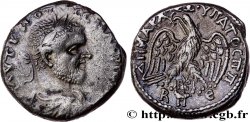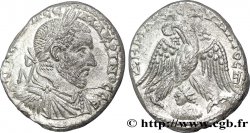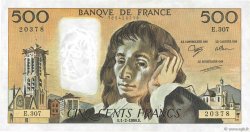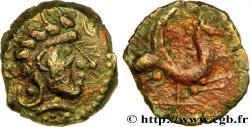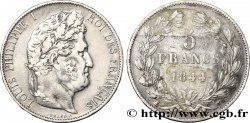E-auction 157-95239 - bpv_173689 - MACRINUS Tétradrachme syro-phénicien
Чтобы принять участие в торгах, вы должны войти в систему и стать подтвержденным участником аукциона. Войдите, чтобы сделать ставку. Ваш аккаунт будет подтвержден в течение 48 часов. Не ждите до закрытия торгов, чтобы зарегистрироваться.Сделав ставку на данный товар, вы вступаете в юридическое соглашение на покупку выбранного товара и нажатием кнопки «Сделать ставку» подтверждаете принятие вами условий интернет-аукционов cgb.fr.
Ставка может бить сделана только в полном эквиваленте евро. Торги закроются согласно времени, указанному в описании товара, все ставки, сделанные после закрытия торгов, учитываться не будут. Не следует откладывать предложение вашей ставки до последнего момента, так как система может не успеть обработать вашу заявку, и ваша ставка не будет принята. Более детальную информацию вы найдёте здесь: FAQ по интернет-аукционам.
БЕСПЛАТНО.
БЕСПЛАТНО.
| Оценить : | 120 € |
| Цена : | 31 € |
| Максимальная предлагаемая цена : | 31 € |
| Конец торгов : | 18 April 2016 15:17:30 |
| Участников : | 7 Участников |
Тип Tétradrachme syro-phénicien
Дата: 217-218
Монетный двор / Город: Hiérapolis, Syrie, Cyrrhestica
Металл: billon
Диаметр: 24 mm
Ориентация осей монеты: 11 h.
Вес: 13,27 g.
Редкость: R1
Комментарии о состоянии
Flan largement trop étroit, légendes incomplètes, lion difficilement visible
Ссылки в каталоге: :
Лицевая сторона
Аверс: описание: Buste de Macrin à droite, lauré, drapé et cuirassé, vu de trois-quarts en avant, les deux rubans pendant derrière la tête (A*).
Аверс: легенда: AUT K. M. OPEL... SE. MAKREINOS SE, (Autokratoros Kaisaros Markos Opellios Seuhros Makrinos Sebastos)
Аверс: перевод: (L’empereur césar Marc Opel Sévère Macrin auguste).
Обратная сторона
Реверс: Описание: Aigle debout à gauche, ailes écartées, la tête et la queue à droite, tenant une couronne feuillée dans son bec ; entre les pattes, un lion passant à droite.
Реверс: легенда: DHMARC. EX. UPATOS
Реверс: перевод: (Revêtu de la puissance tribunitienne consul).
Комментарий
Les frappes de Macrin à Hiérapolis sont assez nombreuses mais bien inférieures à celles de Caracalla et de Diaduménien, dont c’est l’atelier le plus productif, devant même Antioche.
On repère deux graveurs de droit et plusieurs graveurs de revers, une étude des liaisons de coins serait certainement instructive sur la structure de l’émission.
Hiérapolis, "la ville du Soleil" où se trouvait le temple d'Astarté construit par Séleucos Ier Nicator, l'actuelle Manbidj, était située près de l'Euphrate entre Berœa (Alep) à l'ouest et Carrhæ (Harran) à l'Est sur la route des caravanes aux portes de la province de Mésopotamie en Syrie Cyrrhestica.
HIérapolis est un atelier important pour Caracalla mais, curieusement, avec une production concentrée sur le type à droite, drapé et cuirassé, toutes les autres variantes étant frappées en quantités minimes.
L’attribution est certaine : le graveur spécifique à l’atelier se retrouve sur la frappe de présentation avec Hadad et Atargatis trônant avec le semeion, type qui ne peut qu’être attribué à Hiérapolis. La frappe de présentation porte aussi un petit aigle et le symbole du lion passant, aucun doute n’est donc possible.
On notera sur certaines représentations un lion d’une taille relativement importante et d’une qualité de gravure tout à fait remarquable. Il existait probablement encore des lions vivant à l’état sauvage à cette époque dans la région, également des réserves de chasse (paradeisos) où l’artiste a pu observer parfaitement le modèle.
On note que les sigma sont gravés en C.
Dans la base TSP maintenue par Michel Prieur, seize exemplaires sont maintenant répertoriés. Cet exemplaire est le 0943_013.
The strikes of Macrinus at Hierapolis are quite numerous but much inferior to those of Caracalla and Diadumenian, of which it is the most productive workshop, even ahead of Antioch..
We can identify two obverse engravers and several reverse engravers; a study of the die links would certainly be instructive on the structure of the issue..
Hierapolis, \\\"the city of the Sun\\\" where the temple of Astarte was located, built by Seleucus I Nicator, modern Manbij, was located near the Euphrates between Berœa (Aleppo) to the west and Carrhae (Harran) to the east on the caravan route to the gates of the province of Mesopotamia in Syria Cyrrhestica.
Hierapolis is an important mint for Caracalla but, curiously, with production concentrated on the right-hand type, draped and cuirassed, all other variants being struck in minimal quantities.
The attribution is certain: the specific engraver of the workshop is found on the presentation strike with Hadad and Atargatis enthroned with the semeion, a type which can only be attributed to Hierapolis. The presentation strike also bears a small eagle and the lion passant symbol, so there is no doubt.
We will note on certain representations a lion of a relatively large size and of a quite remarkable quality of engraving. There were probably still lions living in the wild in the region at that time, as well as hunting reserves (paradeisos) where the artist was able to observe the model perfectly..
Note that the sigmas are engraved in C.
In the TSP database maintained by Michel Prieur, sixteen examples are now listed. This example is 0943_013
On repère deux graveurs de droit et plusieurs graveurs de revers, une étude des liaisons de coins serait certainement instructive sur la structure de l’émission.
Hiérapolis, "la ville du Soleil" où se trouvait le temple d'Astarté construit par Séleucos Ier Nicator, l'actuelle Manbidj, était située près de l'Euphrate entre Berœa (Alep) à l'ouest et Carrhæ (Harran) à l'Est sur la route des caravanes aux portes de la province de Mésopotamie en Syrie Cyrrhestica.
HIérapolis est un atelier important pour Caracalla mais, curieusement, avec une production concentrée sur le type à droite, drapé et cuirassé, toutes les autres variantes étant frappées en quantités minimes.
L’attribution est certaine : le graveur spécifique à l’atelier se retrouve sur la frappe de présentation avec Hadad et Atargatis trônant avec le semeion, type qui ne peut qu’être attribué à Hiérapolis. La frappe de présentation porte aussi un petit aigle et le symbole du lion passant, aucun doute n’est donc possible.
On notera sur certaines représentations un lion d’une taille relativement importante et d’une qualité de gravure tout à fait remarquable. Il existait probablement encore des lions vivant à l’état sauvage à cette époque dans la région, également des réserves de chasse (paradeisos) où l’artiste a pu observer parfaitement le modèle.
On note que les sigma sont gravés en C.
Dans la base TSP maintenue par Michel Prieur, seize exemplaires sont maintenant répertoriés. Cet exemplaire est le 0943_013.
The strikes of Macrinus at Hierapolis are quite numerous but much inferior to those of Caracalla and Diadumenian, of which it is the most productive workshop, even ahead of Antioch..
We can identify two obverse engravers and several reverse engravers; a study of the die links would certainly be instructive on the structure of the issue..
Hierapolis, \\\"the city of the Sun\\\" where the temple of Astarte was located, built by Seleucus I Nicator, modern Manbij, was located near the Euphrates between Berœa (Aleppo) to the west and Carrhae (Harran) to the east on the caravan route to the gates of the province of Mesopotamia in Syria Cyrrhestica.
Hierapolis is an important mint for Caracalla but, curiously, with production concentrated on the right-hand type, draped and cuirassed, all other variants being struck in minimal quantities.
The attribution is certain: the specific engraver of the workshop is found on the presentation strike with Hadad and Atargatis enthroned with the semeion, a type which can only be attributed to Hierapolis. The presentation strike also bears a small eagle and the lion passant symbol, so there is no doubt.
We will note on certain representations a lion of a relatively large size and of a quite remarkable quality of engraving. There were probably still lions living in the wild in the region at that time, as well as hunting reserves (paradeisos) where the artist was able to observe the model perfectly..
Note that the sigmas are engraved in C.
In the TSP database maintained by Michel Prieur, sixteen examples are now listed. This example is 0943_013








 Cообщить об ошибке
Cообщить об ошибке Распечатать страницу
Распечатать страницу Отправить мой выбор
Отправить мой выбор Задать вопрос
Задать вопрос Consign / sell
Consign / sell
 Информация
Информация